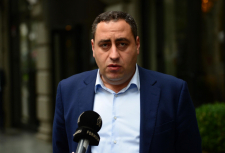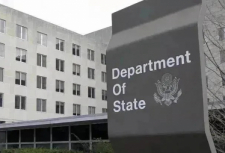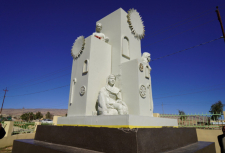Afterword from the book "Shangal" by Tore Rerberk

We present an excerpt from the afterword of the book by the Danish journalist Tore Rerberk, who visited Shangal after the events of 2014, communicated with the local population and recreated the events of those days from the stories of the Yezidis.
One of the indisputable facts about the events of August 2014: the PKK and the People's Self-Defense Units created a corridor, thanks to which thousands of Yazidis were saved from imminent death. The hidden retreat of the Peshmerga army, their blocking of the road from the south side to the top of Shangal to the ordinary population, as well as their disarming of the Yazidis who served in the Iraqi army, are also well — known facts. And they should be an integral part of any narrative about the 2014 genocide. However, they are rarely mentioned. Maybe because this information does not give the story such entertainment as the violence of the "Islamic state" against the Yazidis. However, these facts played a decisive role in the actions of ISIS.
The history of the 2014 genocide is quite difficult, because, unfortunately, many journalists easily fall for the bait of stereotypes and tell about the event by choosing one of the accepted versions. Or as about the struggle between evil (ISIS) and good (represented by the Peshmerga army), who had to flee for his life. Or deliberately ignoring the events preceding the attack, and describing only the terrible humiliations that the Yazidis had to endure. The latter became especially popular in the media, and even the Danish tabloids reprinted stories about executions and torture. The most favorite topic in the press was sex slavery. In Shangala, we tried to convey the context and prehistory of the genocide, without getting bogged down in the stories of human suffering. If we focus only on the suffering, the Yazidis turn into passive victims, although many of them actively resisted. Volunteers in Siba, Girazer and other settlements near the southern slope of the mountain held back the pressure of the "Islamic State" for many hours, thereby allowing thousands of Yazidis to take refuge on the top of the mountain.
Before the events described, at least 400,000 Yazidis lived in Shangala and defended the mountain and the settlements at its foot. Just like our hero Asmail, they were on the periphery of the events that prevented the complete destruction of the Yezidis in Shangala. Asmail is the main protagonist of our story because, among other things, we wanted to tell the story of a simple Yazid. Every Yazidi can tell his own version of the events that took place in the summer of 2014, but since most of the residents of Shangal are peasants, like Asmail, they (and especially those who live on the northern slope) will certainly find similarities with the story of the main character.
...All sources agree that the Peshmerga took away weapons from the Yazidis who served in the Iraqi army, which were left in Shangala after the defeat of the central government in the region. There are different opinions about where it went. Many Yazidis are sure that the weapons were sold on the black market, but there is no evidence of this. In the book "The Last Genocide of the Yazidis", Yazid Kassim Shesho, who fought against ISIS together with hundreds of volunteers at his disposal, shared a curious opinion:
"If the Peshmerga had left the weapons thrown by the Iraqi army to the Yazidis, the Yazidis would have been able to defend themselves. And this catastrophe, the genocide, could have been avoided."
ezidi.news
Tags: #yazidisinfo #newsyazidi #aboutyazidi #Shangal #genocideyazidi
Afterword from the book "Shangal" by Tore Rerberk

We present an excerpt from the afterword of the book by the Danish journalist Tore Rerberk, who visited Shangal after the events of 2014, communicated with the local population and recreated the events of those days from the stories of the Yezidis.
One of the indisputable facts about the events of August 2014: the PKK and the People's Self-Defense Units created a corridor, thanks to which thousands of Yazidis were saved from imminent death. The hidden retreat of the Peshmerga army, their blocking of the road from the south side to the top of Shangal to the ordinary population, as well as their disarming of the Yazidis who served in the Iraqi army, are also well — known facts. And they should be an integral part of any narrative about the 2014 genocide. However, they are rarely mentioned. Maybe because this information does not give the story such entertainment as the violence of the "Islamic state" against the Yazidis. However, these facts played a decisive role in the actions of ISIS.
The history of the 2014 genocide is quite difficult, because, unfortunately, many journalists easily fall for the bait of stereotypes and tell about the event by choosing one of the accepted versions. Or as about the struggle between evil (ISIS) and good (represented by the Peshmerga army), who had to flee for his life. Or deliberately ignoring the events preceding the attack, and describing only the terrible humiliations that the Yazidis had to endure. The latter became especially popular in the media, and even the Danish tabloids reprinted stories about executions and torture. The most favorite topic in the press was sex slavery. In Shangala, we tried to convey the context and prehistory of the genocide, without getting bogged down in the stories of human suffering. If we focus only on the suffering, the Yazidis turn into passive victims, although many of them actively resisted. Volunteers in Siba, Girazer and other settlements near the southern slope of the mountain held back the pressure of the "Islamic State" for many hours, thereby allowing thousands of Yazidis to take refuge on the top of the mountain.
Before the events described, at least 400,000 Yazidis lived in Shangala and defended the mountain and the settlements at its foot. Just like our hero Asmail, they were on the periphery of the events that prevented the complete destruction of the Yezidis in Shangala. Asmail is the main protagonist of our story because, among other things, we wanted to tell the story of a simple Yazid. Every Yazidi can tell his own version of the events that took place in the summer of 2014, but since most of the residents of Shangal are peasants, like Asmail, they (and especially those who live on the northern slope) will certainly find similarities with the story of the main character.
...All sources agree that the Peshmerga took away weapons from the Yazidis who served in the Iraqi army, which were left in Shangala after the defeat of the central government in the region. There are different opinions about where it went. Many Yazidis are sure that the weapons were sold on the black market, but there is no evidence of this. In the book "The Last Genocide of the Yazidis", Yazid Kassim Shesho, who fought against ISIS together with hundreds of volunteers at his disposal, shared a curious opinion:
"If the Peshmerga had left the weapons thrown by the Iraqi army to the Yazidis, the Yazidis would have been able to defend themselves. And this catastrophe, the genocide, could have been avoided."
ezidi.news
Tags: #yazidisinfo #newsyazidi #aboutyazidi #Shangal #genocideyazidi


























